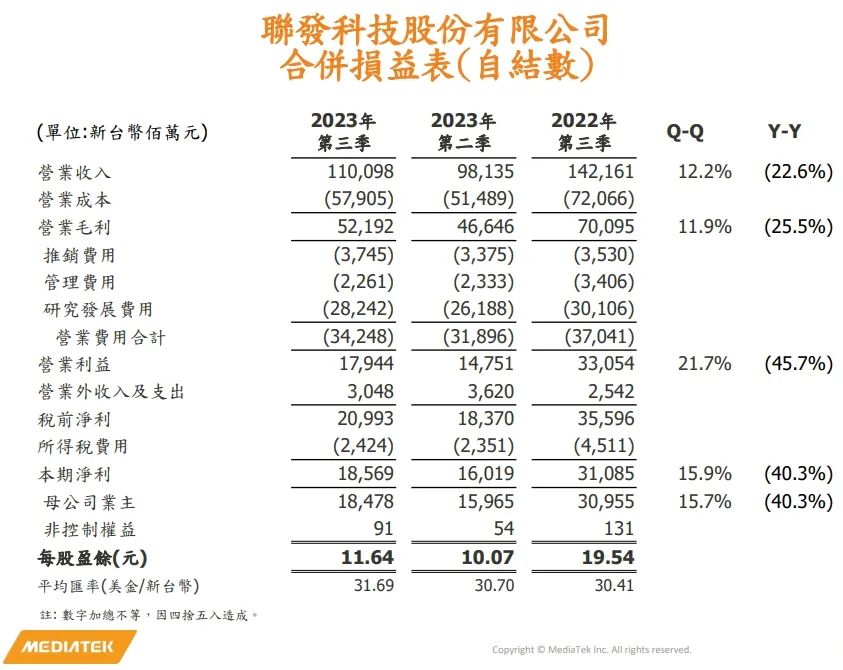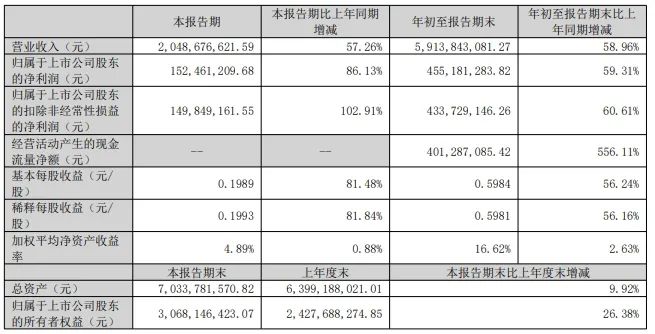Service hotline
+86 0755-83044319
release time:2023-10-28Author source:SlkorBrowse:13650
Industry News
1. MediaTek releases financial report for the third quarter of 2023
On October 27th, MediaTek released its financial report for the third quarter of 2023. According to the report, the net revenue for the third quarter was 110.98 billion New [敏感词] dollars, representing a sequential growth of 12.2%, primarily due to customers replenishing their inventory. However, the net revenue decreased by 22.6% compared to the same period last year, mainly due to a decline in terminal demand. The gross profit for the third quarter was 52.192 billion New [敏感词] dollars, with a sequential increase of 11.9%, but a year-on-year decrease of 25.5%. The gross profit margin was 47.4%, a decrease of 0.1 percentage points from the previous quarter and a decrease of 1.9 percentage points from the same period last year. The net profit for the third quarter of MediaTek was 18.48 billion New [敏感词] dollars, a 40% decrease compared to the same period last year, estimated at 16.79 billion New [敏感词] dollars.

2. IDC: China's smartphone market declined by 6.3% YoY in the third quarter, with Honor taking the top spot and China's top technology enterprise leading in foldable screens.
According to IDC's quarterly smartphone tracking report for the third quarter of 2023, the shipment volume of China's smartphone market was approximately 67.05 million units, a decrease of 6.3% compared to the same period last year. Most manufacturers remained cautious during this quarter, controlling shipments while actively clearing channel inventory in preparation for the concentrated release of new products in the next quarter. With the gradual start of a new replacement cycle, the shipment volume of China's smartphone market is expected to reach a turning point in the fourth quarter of 2023, marking the first rebound in nearly 10 quarters.
Despite the lackluster overall market performance, the foldable screen smartphone market showed promising growth. In the third quarter of 2023, the Chinese foldable screen smartphone market continued its rapid growth trend, with a YoY growth of 90.4%. In the first three quarters, China's top technology enterprise maintained the top market share at 31.7%, showing a clear advantage. OPPO ranked second with a 17.9% market share, followed by Samsung at 15.4%. Honor secured the fourth position with a 15.1% share, while vivo ranked fifth with a 12.7% share. Xiaomi held a market share of 5.2%. IDC's senior analyst, Guo Tianxiang, pointed out that although the data from the third quarter does not yet indicate an improvement in China's smartphone market, the recent increase in market enthusiasm suggests a noticeable recovery in consumer demand.
3. The world's first AI security research institute to be established in the UK.
According to Sina Finance on October 27th, UK Prime Minister Su Nake announced plans to establish the world's first AI security research institute and hold an AI Security Summit on November 1-2. This summit will bring together AI companies, governments, civil society organizations, and experts in related fields from around the world to discuss how to reduce the risks posed by AI through international coordinated actions. Su Nake stated that the upcoming research institute will promote global understanding of AI security and conduct careful research, evaluation, and testing of new AI technologies to understand the capabilities of each new model and explore all risks from "bias and misinformation" to "extreme risks."
Su Nake said, "AI can make the production of chemical or biological tools easier, but this technology can also be exploited by criminals. In the most unlikely but extreme cases, humans may even lose control completely in the face of AI, sometimes referred to as superintelligence." In addition, at the AI Security Summit next week, Su Nake will propose the establishment of a "truly global expert group," whose members will be nominated by participating countries and organizations. A report on the current status of AI science will also be released.
4. Tencent's MixNet model opens AIGC WenShengTu (Text-to-Image) capability.
According to Cailian Press on October 27th, after its limited debut on September 7th, Tencent's MixNet, which has rarely appeared in public, has announced its latest research and development progress. In this update, MixNet has mainly made advancements in Chinese language, mathematics, code, and text-to-image capabilities. The official statement mentioned that in terms of Chinese language capabilities, MixNet surpasses GPT3.5 overall, and its code processing performance outperforms ChatGPT6.34%.
In terms of specific applications, Tencent engineers can now use MixNet for code generation, code completion, code vulnerability detection and repair, table data processing, database queries, and other tasks. For example, in an IDE programming scenario, Tencent's Gitee Copilot integrates MixNet to generate corresponding code based on comments or intelligently complete code based on context. The highlight of MixNet's latest upgrade is the opening of its text-to-image capability, which can now be experienced directly in the MixNet Assistant WeChat mini-program.
5. Solidigm, a solid-state storage manufacturer, initiates layoffs due to industry downturn.
According to Global Network on October 27th, Solidigm, a solid-state storage manufacturer, confirmed that it has started layoffs due to the industry downturn. Solidigm revealed that it conducted "moderate layoffs" on Wednesday but declined to provide further details. In a statement, Solidigm stated, "Due to the long-term downturn in the semiconductor industry and its impact on market conditions, Solidigm has implemented layoffs." The company is providing support and severance pay to colleagues who will be leaving.
Solidigm is a new brand established by SK hynix after its acquisition of Intel's NAND solid-state drive business in 2020. According to the agreement with SK hynix, Intel transferred some employees from its NAND division to Solidigm to operate its SSD business.
Transport Layer
6. Guanghetong releases its Q3 2023 financial report
On October 27th, Guanghetong released its Q3 2023 financial report, which showed that the company achieved a revenue of 2.049 billion yuan, a year-on-year increase of 57.26%; a net profit attributable to shareholders of the listed company of 152 million yuan, a year-on-year increase of 86.13%; and a net profit attributable to shareholders of the listed company after deducting non-recurring gains and losses of 150 million yuan, a year-on-year increase of 102.91%. In the first three quarters of 2023, Guanghetong achieved a revenue of 5.914 billion yuan, a year-on-year increase of 58.96%. Guanghetong stated that the growth in operating income during the reporting period was mainly due to the inclusion of Ralink Wireless into the scope of consolidation and the company's good expansion in industries such as automotive and FWA.
Founded in 1999, Guanghetong became China's first wireless communication module company to go public in 2017. The company has been committed to promoting the wireless communication technology and application of IoT and mobile internet, as well as the application and expansion of its solutions. It has strong research and development capabilities in communication technology, radio frequency technology, data transmission technology, and signal processing technology. Guanghetong is a professional product and solution provider with independent intellectual property rights in the field of wireless communication technology. In the IoT industry chain, Guanghetong is in the network layer and involves cross-disciplinary areas with the perception layer.

7. The first Guangdong-Hong Kong-Macao 5G vehicle communication interconnection has been launched
On October 27th, the Science and Technology Innovation Board Daily reported that China Telecom's subsidiary, Tianyi IoT Technology Co., Ltd., announced that it had helped GAC Group achieve autonomous roaming services for 5G in Guangdong, Hong Kong, and Macao, enabling seamless connection between the in-vehicle networks of mainland China and Hong Kong and Macao regions for car owners. This ensures high-speed online access to 5G networks for vehicles traveling between the three regions, creating the first benchmark case for autonomous roaming in the automobile industry between Hong Kong and Macao.
This year, Tianyi IoT and GAC Group jointly established the Greater Bay Area interconnection project team, and based on the differences in network standards, frequency bands, and data channel configurations between Guangdong, Hong Kong, and Macao, the two parties formulated detailed technical and implementation plans. In order to reduce inconvenience caused by car owners having to return to the factory for upgrades, Tianyi IoT's technical team innovatively developed a networking solution, allowing users to roam onto overseas operators' networks through a self-built private network, supporting multiple business scenarios such as 5G public network, customized multi-DNN, and GRE VPDN intranet. Car manufacturers/car owners do not need to change the vehicle configuration and can quickly switch from domestic car networking with multiple APNs to a dedicated APN for domestic roaming.
Application Layer
8. General Motors' Cruise suspends all autonomous driving operations for its fleets.
On October 26th, Cruise, General Motors' autonomous driving company, announced on social media platform X that it has decided to voluntarily suspend all autonomous driving operations for its fleets. This effectively terminates the company's autonomous driving taxi service in California and Miami. The company will take time to review its processes, systems, and tools, and consider how to operate better to rebuild public trust. Cruise stated that this decision is not related to any new road accidents. It also stated that it will continue to conduct "supervised autonomous vehicle operations," meaning human operators will continue to sit behind the wheel of autonomous taxis.
9. Boston Dynamics uses ChatGPT to train its four-legged robot and develop a guide dog robot.
According to the Science and Technology Innovation Board Daily on October 27th, robot developer Boston Dynamics showcased a new study on its official website. By combining ChatGPT, Spot, and other AI models, the company developed a talking guide dog robot. The robot can converse with humans based on text and voice prompts and provides visual question-answering functionality by analyzing images captured by cameras and generating image descriptions.
10. Accelerating the Scale Application of Beidou Navigation System in Multiple Fields.
Xinhua News Agency reported on October 27th that at the opening of the Second Beidou Navigation System International Summit, it was revealed that China's Beidou core industry scale will exceed 140 billion yuan in 2022. "Beidou+" and "+Beidou" are widely used in transportation, communication, agriculture, meteorology, electricity, and other fields, helping various industries accelerate their digital and intelligent transformation. Next, China will aim at industrial development and consumer upgrades, promote the innovation and development of the entire industrial chain of Beidou chips, modules, terminals, and expand the application of Beidou in emerging fields such as the industrial internet, the Internet of Things, and the connected car, to continue to strengthen and expand the Beidou industry.









Site Map | 萨科微 | 金航标 | Slkor | Kinghelm
RU | FR | DE | IT | ES | PT | JA | KO | AR | TR | TH | MS | VI | MG | FA | ZH-TW | HR | BG | SD| GD | SN | SM | PS | LB | KY | KU | HAW | CO | AM | UZ | TG | SU | ST | ML | KK | NY | ZU | YO | TE | TA | SO| PA| NE | MN | MI | LA | LO | KM | KN
| JW | IG | HMN | HA | EO | CEB | BS | BN | UR | HT | KA | EU | AZ | HY | YI |MK | IS | BE | CY | GA | SW | SV | AF | FA | TR | TH | MT | HU | GL | ET | NL | DA | CS | FI | EL | HI | NO | PL | RO | CA | TL | IW | LV | ID | LT | SR | SQ | SL | UK
Copyright ©2015-2025 Shenzhen Slkor Micro Semicon Co., Ltd